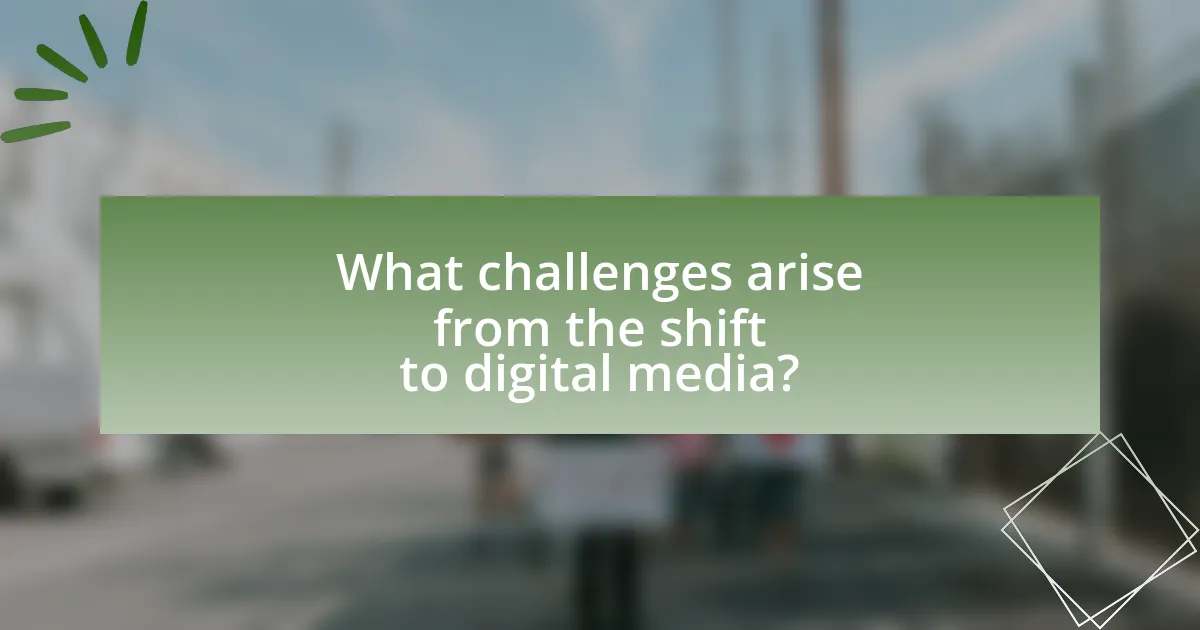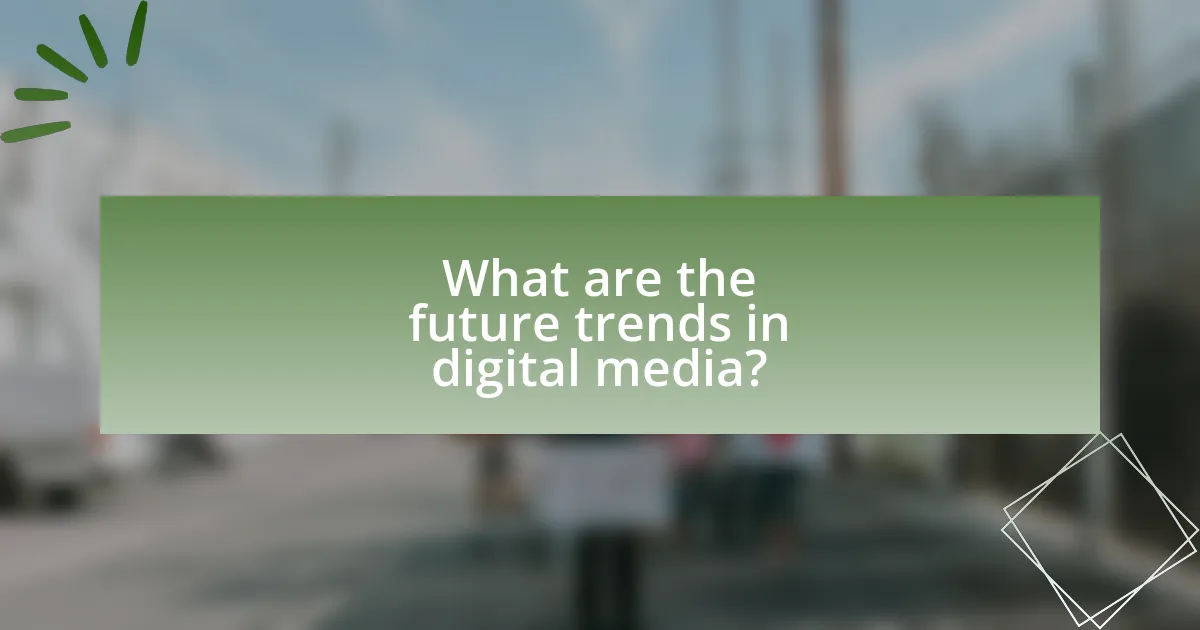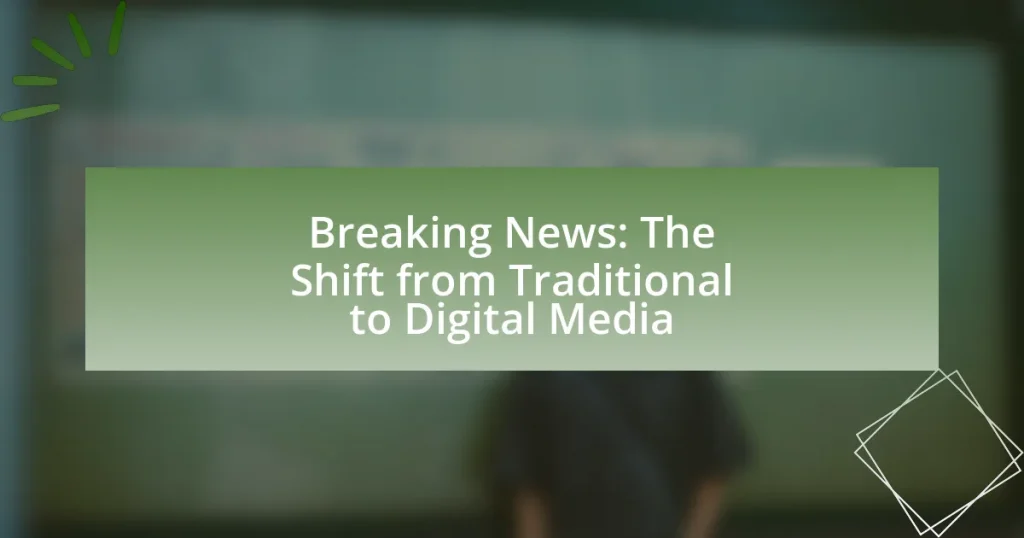The article “Breaking News: The Shift from Traditional to Digital Media” examines the transition from traditional media formats, such as print and broadcast, to digital platforms and social media. It highlights the significant changes in information creation, distribution, and consumption, driven by technological advancements and changing consumer behaviors. Key topics include the characteristics of traditional versus digital media, the impact of this shift on audience engagement, the challenges posed by misinformation, and the strategies traditional media outlets are adopting to remain relevant. Additionally, the article explores future trends in digital media, including the role of artificial intelligence and the importance of audience preferences in shaping content delivery.

What is the Shift from Traditional to Digital Media?
The shift from traditional to digital media refers to the transition in how information is created, distributed, and consumed, moving from print, radio, and television to online platforms and social media. This change has been driven by advancements in technology, with the rise of the internet and mobile devices enabling instant access to content. According to a Pew Research Center report, as of 2021, 86% of Americans get their news from digital devices, highlighting the significant decline in traditional media consumption. This shift has transformed advertising strategies, audience engagement, and the overall landscape of media consumption, making digital platforms the primary source of news and information for many.
How has the definition of media evolved over time?
The definition of media has evolved from traditional forms, such as print and broadcast, to encompass digital platforms and social media. Initially, media referred primarily to newspapers, radio, and television, which served as the main channels for information dissemination. With the advent of the internet in the late 20th century, the definition expanded to include digital content, online news outlets, and social media platforms, reflecting a shift in how information is created, shared, and consumed. This evolution is evidenced by the rise of user-generated content and the decline of traditional print media, as seen in the Pew Research Center’s report indicating that digital news consumption surpassed print for the first time in 2018.
What are the key characteristics of traditional media?
Traditional media is characterized by its one-way communication, established formats, and reliance on scheduled programming. This form of media, which includes television, radio, newspapers, and magazines, primarily delivers content to a passive audience without immediate interaction. Traditional media often adheres to specific time slots and publication schedules, creating a structured approach to information dissemination. For instance, television broadcasts are scheduled at particular times, and newspapers are printed daily or weekly, limiting the immediacy of news updates compared to digital platforms. Additionally, traditional media typically employs professional gatekeepers, such as editors and producers, who curate content, ensuring a level of quality and credibility. This contrasts with digital media, where user-generated content can proliferate without such oversight.
What defines digital media in contrast to traditional media?
Digital media is defined by its reliance on electronic devices for content creation, distribution, and consumption, contrasting with traditional media, which primarily uses physical formats like print and broadcast. Digital media encompasses platforms such as websites, social media, and streaming services, allowing for interactive and real-time engagement, while traditional media is characterized by one-way communication and delayed feedback. The rise of digital media is evidenced by statistics showing that as of 2023, over 4.9 billion people globally use the internet, highlighting a significant shift in how audiences access information compared to the declining circulation of print newspapers and viewership of traditional television.
Why is this shift significant in today’s society?
The shift from traditional to digital media is significant in today’s society because it fundamentally alters how information is consumed and disseminated. This transition enables instant access to news and diverse viewpoints, fostering a more informed public. According to a Pew Research Center study, as of 2021, 86% of Americans get their news from digital devices, highlighting the dominance of digital platforms over traditional media. This shift not only enhances the speed of information delivery but also democratizes content creation, allowing individuals and smaller entities to contribute to the media landscape, thereby increasing representation and diversity in news coverage.
What impact does digital media have on information dissemination?
Digital media significantly enhances the speed and reach of information dissemination. Unlike traditional media, which often involves longer production and distribution timelines, digital platforms allow for real-time sharing and access to information across global audiences. For instance, a study by the Pew Research Center found that 62% of Americans get their news from social media, illustrating how digital channels have become primary sources for information. This shift enables immediate updates and broader engagement, allowing users to interact with content and share it rapidly, thereby amplifying its reach and impact.
How does the shift affect audience engagement and interaction?
The shift from traditional to digital media significantly enhances audience engagement and interaction. Digital platforms allow for real-time communication, enabling audiences to participate in discussions, share content, and provide immediate feedback. According to a study by the Pew Research Center, 62% of adults in the U.S. get news from social media, which fosters a more interactive environment compared to traditional media, where audience engagement is typically passive. This transition has led to increased user-generated content and a more dynamic relationship between media producers and consumers, ultimately resulting in higher levels of audience involvement and interaction.
What are the driving forces behind the transition to digital media?
The driving forces behind the transition to digital media include technological advancements, changing consumer behavior, and the demand for instant access to information. Technological advancements, such as the proliferation of smartphones and high-speed internet, have made digital content more accessible. Changing consumer behavior reflects a preference for on-demand content consumption, with statistics showing that over 80% of adults in the U.S. consume news digitally. Additionally, the demand for instant access to information has led to the decline of traditional media formats, as consumers increasingly seek real-time updates through digital platforms.
How has technology influenced media consumption habits?
Technology has significantly influenced media consumption habits by enabling instant access to diverse content across multiple platforms. The rise of smartphones and high-speed internet has shifted audiences from traditional media, such as television and newspapers, to digital formats, including streaming services and social media. For instance, a 2021 report by the Pew Research Center indicated that 86% of Americans get news from digital devices, highlighting a clear preference for online sources over print. This transition has led to changes in how content is produced and consumed, with an emphasis on on-demand viewing and personalized experiences.
What role do social media platforms play in this shift?
Social media platforms serve as critical catalysts in the shift from traditional to digital media by enabling real-time news dissemination and audience engagement. These platforms allow users to share and consume news instantly, which contrasts sharply with the delayed reporting typical of traditional media outlets. For instance, a Pew Research Center study found that 62% of adults in the U.S. get news from social media, highlighting its significant role in shaping public discourse and information access. Additionally, social media facilitates user-generated content, empowering individuals to report news events as they happen, further accelerating the transition to a digital-first news landscape.

What challenges arise from the shift to digital media?
The challenges arising from the shift to digital media include issues such as information overload, decreased attention spans, and the spread of misinformation. Information overload occurs as consumers are bombarded with vast amounts of content, making it difficult to discern credible sources. Research indicates that the average person encounters over 5,000 advertisements daily, leading to reduced attention spans and difficulty in retaining information. Additionally, the rapid dissemination of information online facilitates the spread of misinformation, with studies showing that false news stories are 70% more likely to be retweeted than true stories. These challenges significantly impact how audiences engage with news and information in the digital landscape.
How do traditional media outlets adapt to digital platforms?
Traditional media outlets adapt to digital platforms by integrating multimedia content, utilizing social media for distribution, and implementing paywalls for online subscriptions. These adaptations allow traditional media to reach broader audiences and engage users through interactive formats. For instance, newspapers have developed mobile applications and websites that feature videos, podcasts, and live updates, enhancing user experience and accessibility. According to a 2021 Pew Research Center study, 86% of U.S. adults get news from digital devices, highlighting the necessity for traditional media to evolve in response to changing consumer behaviors.
What strategies are being implemented by traditional media to stay relevant?
Traditional media is implementing strategies such as digital transformation, audience engagement through social media, and content diversification to stay relevant. Digital transformation involves adopting online platforms and technologies to reach audiences where they consume content, evidenced by major newspapers launching mobile apps and websites to provide real-time news updates. Audience engagement through social media allows traditional media outlets to interact directly with viewers, fostering community and feedback, as seen with platforms like Twitter and Facebook being used for live reporting and audience polls. Content diversification includes producing podcasts, video content, and interactive articles, which cater to varying consumer preferences and habits, as demonstrated by networks like NPR and BBC expanding their offerings beyond traditional broadcasting.
What are the risks of failing to adapt to digital media?
Failing to adapt to digital media poses significant risks, including loss of audience engagement and decreased market competitiveness. Organizations that do not embrace digital platforms may experience a decline in visibility, as 54% of consumers prefer digital channels for news consumption, according to a Pew Research Center study. Additionally, businesses risk losing revenue opportunities, as digital advertising spending is projected to surpass traditional advertising by 2024, highlighting the financial implications of not transitioning. Furthermore, companies may face reputational damage, as consumers increasingly expect brands to have a robust online presence.
What ethical concerns are associated with digital media?
Ethical concerns associated with digital media include issues of privacy, misinformation, and digital manipulation. Privacy is compromised as personal data is often collected without explicit consent, leading to potential misuse. Misinformation spreads rapidly through social media platforms, impacting public opinion and decision-making, as evidenced by studies showing that false news stories are 70% more likely to be retweeted than true ones. Digital manipulation raises concerns about the authenticity of content, as deepfakes and altered images can mislead audiences, undermining trust in media sources.
How does misinformation spread in the digital landscape?
Misinformation spreads in the digital landscape primarily through social media platforms, where content can be rapidly shared and amplified. Algorithms on these platforms often prioritize engagement over accuracy, leading to the viral dissemination of misleading information. A study by the Massachusetts Institute of Technology found that false news stories are 70% more likely to be retweeted than true stories, highlighting the ease with which misinformation can gain traction. Additionally, the anonymity of the internet allows individuals to create and share false narratives without accountability, further exacerbating the issue.
What measures can be taken to combat fake news in digital media?
To combat fake news in digital media, implementing fact-checking initiatives is essential. Fact-checking organizations, such as Snopes and FactCheck.org, verify claims and provide accurate information to counter misinformation. Additionally, promoting media literacy among users helps individuals critically evaluate sources and discern credible information from false narratives. Research indicates that media literacy programs can significantly improve critical thinking skills, enabling users to identify misleading content. Furthermore, social media platforms can enhance their algorithms to flag or reduce the visibility of false information, as seen in Facebook’s efforts to partner with fact-checkers. These measures collectively contribute to a more informed public and a reduction in the spread of fake news.

What are the future trends in digital media?
Future trends in digital media include the rise of artificial intelligence, increased personalization, and the growth of immersive technologies such as virtual and augmented reality. Artificial intelligence is transforming content creation and distribution, enabling more efficient targeting and engagement strategies. Personalization is becoming essential, with data analytics driving tailored experiences for users, as evidenced by the fact that 80% of consumers are more likely to make a purchase when brands offer personalized experiences. Immersive technologies are expected to enhance storytelling and user interaction, with the virtual reality market projected to reach $57.55 billion by 2027, according to a report by Fortune Business Insights. These trends indicate a significant shift towards more interactive, user-centric digital media experiences.
How is artificial intelligence shaping the future of media?
Artificial intelligence is transforming the future of media by enabling personalized content delivery and automating production processes. AI algorithms analyze user data to tailor news feeds and recommendations, enhancing user engagement; for instance, platforms like Netflix and Spotify utilize AI to suggest content based on viewing and listening habits. Additionally, AI-driven tools streamline content creation, such as automated video editing and news generation, exemplified by the Associated Press using AI to produce thousands of earnings reports quickly. This shift not only increases efficiency but also allows media companies to focus on high-quality storytelling and investigative journalism.
What innovations are emerging in content creation and distribution?
Innovations in content creation and distribution include the rise of artificial intelligence tools for automated content generation, enhanced data analytics for audience targeting, and the use of blockchain technology for secure content ownership and distribution. AI tools, such as OpenAI’s GPT models, enable creators to generate text, images, and videos rapidly, significantly reducing production time. Data analytics platforms allow content distributors to analyze viewer behavior and preferences, leading to more personalized content delivery. Blockchain technology ensures transparency and security in transactions, allowing creators to maintain control over their intellectual property while facilitating direct monetization through smart contracts. These innovations are reshaping how content is produced, shared, and consumed in the digital landscape.
How might audience preferences evolve in the coming years?
Audience preferences are likely to evolve towards more personalized and interactive digital experiences in the coming years. As technology advances, consumers increasingly favor content that is tailored to their interests and delivered through platforms that allow for real-time engagement. For instance, a 2021 report by the Pew Research Center indicated that 53% of Americans prefer getting news from social media, reflecting a shift towards platforms that offer customized content feeds. Additionally, the rise of artificial intelligence in content curation is expected to further enhance personalization, making it easier for audiences to access news that aligns with their preferences. This trend suggests a significant move away from traditional media formats, as audiences seek more dynamic and relevant news consumption experiences.
What best practices should media professionals adopt in a digital world?
Media professionals should adopt best practices such as embracing multimedia storytelling, prioritizing audience engagement, and ensuring accuracy and transparency in their reporting. Embracing multimedia storytelling allows professionals to utilize various formats like video, audio, and interactive graphics, which enhance the audience’s understanding and retention of information. Prioritizing audience engagement involves actively interacting with readers through social media and comments, fostering a community around the content. Ensuring accuracy and transparency is critical, as studies show that 86% of consumers consider transparency important when choosing a brand, which directly applies to media credibility. These practices not only improve the quality of content but also build trust and loyalty among audiences in the digital landscape.
How can media organizations enhance their digital presence effectively?
Media organizations can enhance their digital presence effectively by adopting a multi-platform strategy that includes optimizing their websites for mobile devices, utilizing social media for engagement, and producing high-quality, shareable content. Research indicates that 54% of users access news via mobile devices, highlighting the necessity for mobile optimization. Additionally, leveraging social media platforms can increase audience interaction; for instance, organizations that actively engage on platforms like Twitter and Facebook see a 20% increase in audience reach. Furthermore, creating compelling content that resonates with target demographics encourages sharing, which can amplify visibility and attract new audiences.
What skills are essential for success in the digital media landscape?
Essential skills for success in the digital media landscape include proficiency in content creation, data analytics, social media management, and SEO optimization. Content creation skills enable professionals to produce engaging and relevant material that attracts audiences. Data analytics skills are crucial for interpreting audience behavior and measuring campaign effectiveness, with 70% of marketers stating that data-driven decisions enhance their marketing strategies. Social media management skills facilitate effective communication and brand engagement across platforms, while SEO optimization skills ensure content visibility in search engines, which is vital as 93% of online experiences begin with a search engine. These skills collectively empower individuals to navigate and thrive in the evolving digital media environment.




